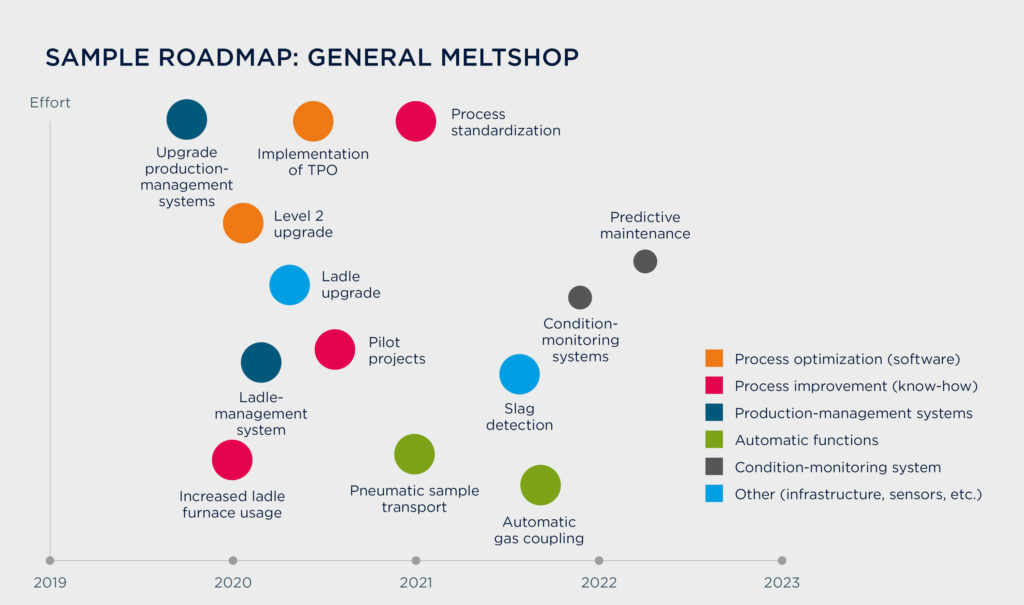In the steel industry, it is an undisputed truth that producers must embrace digitalization to prepare their businesses for increased competition and ever more stringent environmental regulations. Terms like data analytics, artificial intelligence (AI), or interconnected systems are more than just buzz words; they are critical concepts and the cornerstones of any steel plant’s digitalization roadmap. Consequently, data—or, more specifically, data availability and utilization—has become the primary focus of Chief Technology Officers and Chief Digitalization Officers alike.
In Business-to-Consumer (B2C) scenarios, turning raw data into valuable insights to add value can be relatively straightforward. Historical data is collected and pooled in a so-called “data lake”—a storage repository capable of holding vast amounts of raw data in its native format—, allowing reports to be prepared using business-intelligence tools or generating insights using data analytics and AI to improve business performance.
There are countless predictive analytics tools on the market, available off-the-shelf from giants such as SAP and IBM, that can help companies identify trends and make predictions about future events using data mining, statistical algorithms, predictive modeling, and machine learning. The current data is overlaid with the patterns revealed by the historical data to predict what might happen next. The ability to accurately forecast future business outcomes such as product demand, resource requirements, or financial performance can hand a company a significant competitive edge.
Digitalization solutions developed by Primetals Technologies are designed to analyze data, determine patterns, provide insights, and automatically implement recommended actions.

From insights to actions
Yet, the steel industry is unique because there is no one-size-fits-all solution for moving plant operations comprehensively into the digital realm. So what is it that makes the steel industry so different? Contrary to commercially-oriented optimization processes in the B2C sector, where the data is highly accurate and there is a wealth of data sets with a small number of data points, the number of data sets in steel production is lower. Still, each data set has a large number of data points. Thus, the number of data errors
is also higher.
Compared with the use of predictive analysis in B2C, where tangible benefits include being able to identify new business opportunities, gain insights into competitors, reduce costs, and optimize products and performance, the significant advantage of leveraging raw historical data in steel production comes from turning the data into actionable information.
Digital optimization
Digitalization solutions, such as those developed by Primetals Technologies, can analyze the data, determine patterns, and provide insights, as you would expect. But effective digitalization means automating the provision of actionable information and the generation of insights and taking the recommended action automatically, which results in a closed-loop scenario. Importantly, there is another prerequisite for a closed-loop implementation to work: the data required to derive the appropriate actions must be available. Here, plant automation is the solid foundation that can, on the one hand, provide this data and, on the other, execute the resulting actions.
Primetals Technologies’ Through-Process Optimization (TPO) collects high-resolution data related to the process chain and to product quality, so that information about each coil, slab, billet, or bloom is available at every single stage of production.
As a result, TPO helps realize two crucial aspects of process and product optimization. For example, suppose a product shows deviations from the targeted quality parameters. In that case, TPO will indicate what measures need to be taken at subsequent processing steps to compensate for these deviations and still achieve the desired quality. Second, TPO can use the data it collects to optimize the production process for various targets such as costs, process stability, reduced need for alloying agents, and more.

Flexbility, quality, productivity
Expert systems, which Primetals Technologies has developed for several types of aggregates, are a good starting point for digitalization systems. They encompass a predefined knowledge base continuously being added to and enhanced. To illustrate the resulting benefit, imagine a plant’s best operator. Now, imagine one who is not only thoroughly skilled based on experience but also never stops learning, never leaves the plant, and never resigns.
There is a broad range of options in terms of how digitalization in a plant can facilitate improvements. In the areas of quality, digitalization ensures all products are within the predefined range of quality parameters. In productivity, digitalization can increase output and reduce costs, and in regards to flexibility, digitalization can adapt to new products or different raw-material mixes. How digitalization fits into steel production depends on each steel plant’s automation landscape and the business strategy defined by the producer. Digitalization is an ongoing process, and each steel producer can define their digitalization strategy and implementation roadmap.
Proven solutions
Several insightful Industry 4.0 studies of all shapes and sizes have already been carried out with customers worldwide. For example, in one comparatively small study for a European steel producer interested in installing a Production-Management System (PMS), Primetals Technologies identified a shortfall in the existing automation system. Primetals Technologies discovered the plant’s production units could not provide the data required for the PMS. Instead, the operator would have entered the data manually, which implies a high risk of error. Primetals Technologies recommended improvements to the existing automation landscape so that the required data could be fed into the PMS. As a consequence, the production orders from the PMS could now be executed—all in a fully automated closed-loop scenario.
On a larger scale, another study for a South American steel producer with two different production facilities—one mini-mill and one integrated steel plant—with different automation landscapes led to an implementation roadmap and a cost-and-impact analysis. Now, several modifications and upgrade packages are being installed as part of an ongoing project: from dedicated sensor systems for certain plant sections to a full-fledged PMS.
Digitalization in the steel industry requires a unique approach and the development of bespoke automation solutions, such as those being pioneered by Primetals Technologies, where industry-specific expertise is combined with predictive analytics and automation competence to equip steel plants with the tools they need to implement their digitalization strategies and roadmaps to sustainable success.


